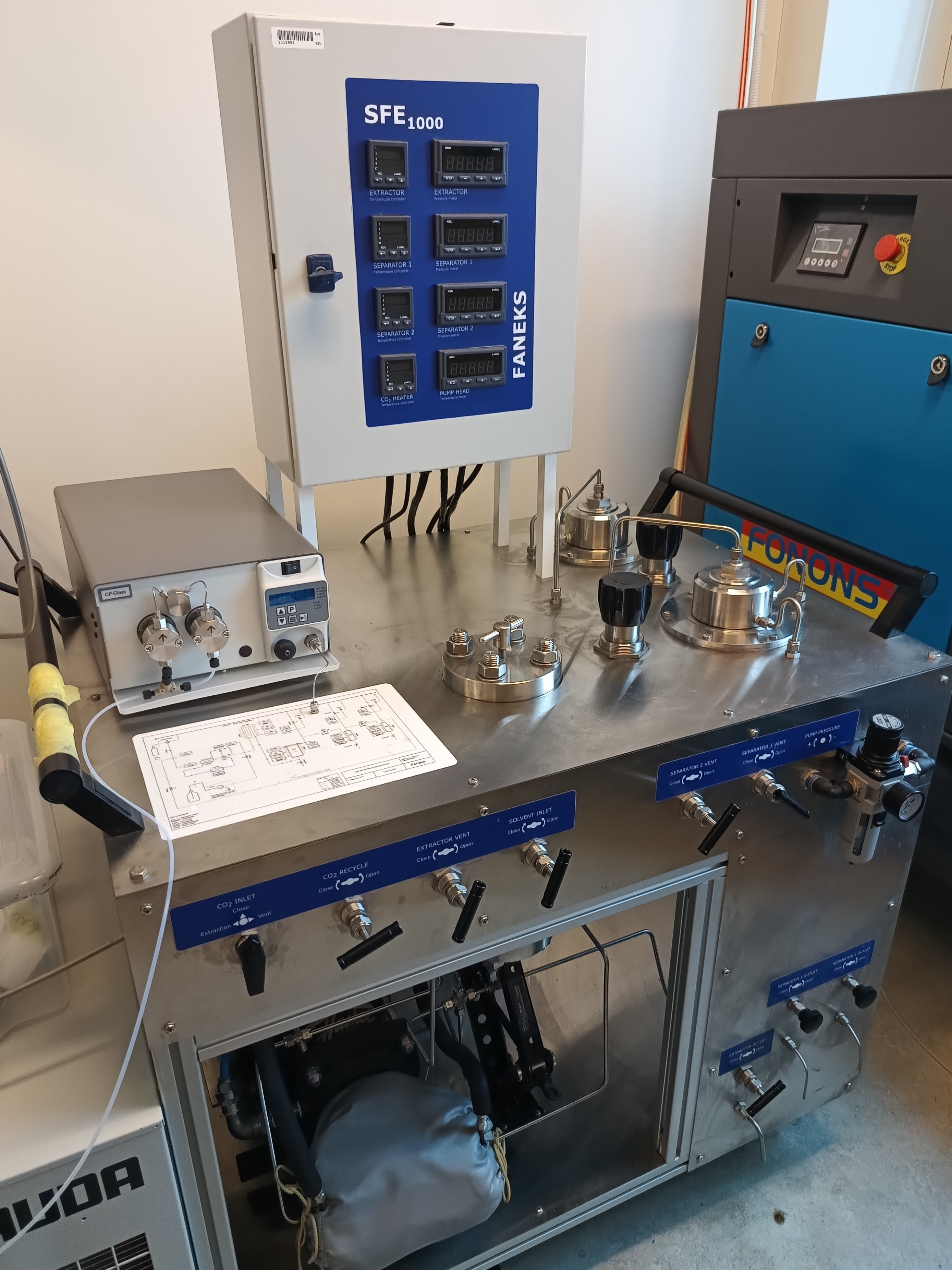Supercritical CO2 fluid extraction system SFE1000
- Supercritical CO2 extraction can be used to extract non-polar compounds from various materials. CO2 reaches the supercritical state at 74 bar and 31.1 °C. When a CO2 molecule is in the supercritical state, it exhibits both liquid and gas properties, which enables CO2 to act as a solvent. The maximum working pressure of the equipment is 270 bar and the working temperature range is 30-100°C.
- Extraction can be performed by using only supercritical CO2 fluid as the sole solvent or by adding ethanol as a cosolvent.
- The device is equipped with two separators, which allow for selective extraction at certain pressures and temperatures, if it is known under what conditions (pressure and temperature) the extract of interest can be separated from the supercritical CO2 solution.
- The properties of the supercritical fluid can be altered by varying the pressure and temperature, allowing selective extraction. For example, volatile oils can be extracted from a plant with low pressures (100 bar), whereas liquid extraction can also remove lipids. Lipids can be removed using pure CO2 at higher pressures (150-250 bar), and then phospholipids can be removed by adding ethanol to the solvent. The same principle can be used to extract polyphenols and unsaturated fatty acids.
- Supercritical CO2 extraction is a widely used method for the extraction of lipids, phospholipids, essential oils and other bioactive substances from plant and animal samples. The advantages of supercritical CO2 extraction are the selectivity of supercritical CO2, the complete separation of samples from the solvent after extraction (the supercritical CO2 solution separates from the extract in a gaseous state after extraction) and the possibility of extraction at low temperatures (+30°C), which is a great advantage for extraction of bioactive fat-soluble compounds (vitamins, pigments, antioxidants, essential oils, etc.).
- Samples can only be extracted dry (<5% moisture), so we offer to dry the samples using our drying oven (105°C, 24 hours) or for thermosensitive samples it is possible to use our sublimator (drying at -20 to -40°C for 5 days).
- Before extracting the samples using the supercritical CO2 system, it is also possible to determine the total oil content of the samples using the Bligh & Dyer method, which helps to compare how complete the supercritical CO2 extraction was.
- Supercritical CO2 extraction can be used to extract non-polar compounds from various materials. The maximum working pressure of the equipment is 270 bar and the working temperature range is 30-100°C.
- The sample amount depends on the density of the dried sample. The volume in the extraction vessel is 1000ml. Usually, 150-300g of dry sample can fit in the 1000ml extraction vessel.
- Extraction can be performed by using only supercritical CO2 fluid as the sole solvent or by adding ethanol as a cosolvent.
- The device is equipped with two separators, which allow for selective extraction at certain pressures and temperatures, if it is known under what conditions (pressure and temperature) the extract of interest can be separated from the supercritical CO2 solution.
- We offer service for extraction of samples using supercritical CO2 extraction. Supercritical CO2 (SC-CO2) extraction is done in 100ml or 1000ml extraction vessels. For 1000ml vessel, at least 1kg of dried sample needs to be provided. Or a wet sample can be provided in sufficient amount, which after drying should make up 1kg of dried sample.
- Samples can only be extracted dry (<5% moisture), so we offer to dry the samples using our drying oven (105°C, 24 hours) or for thermosensitive samples it is possible to use our sublimator (drying at -20 to -40°C for 5 days).
- Before extracting the samples using the supercritical CO2 system, it is also possible to determine the total oil content of the samples using the - Bligh & Dyer method, which helps to compare how complete the supercritical CO2 extraction has been.
